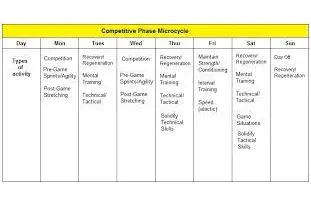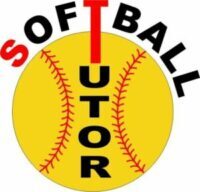
A softball microcycle is essentially a weekly plan. Where all the day to day training and competition activities are planned. All physical, technical/tactical and mental training components can be planned from this place. By having the Microcycles numbered, it is easier to associate specific weeks with specific yearly training plan goals.
They will not all be the same as they will depend on the location within the annual plan and the training objectives to be accomplished. The important thing to remember is that the CNS (Central Nervous System) needs to be recovered in order to benefit from training.
Softball Microcycle Considerations
The following factors will determine the characteristics of your microcycle:
- age of your athletes
- the objectives of the microcycle
- resources and facilities available
- time availability of your athletes
- condition of your athletes
- level of play
- location in your annual plan
- your long term plan
Without considering your players and their abilities, you cannot possibly plan a microcycle or season of optimum success. It is important to plan activities that your softball players can handle physically and psychologically to prevent over training and injury.
Intensity level order:
1. Medium intensity technical activities
- ground balls
- hitting
2. Submax/Max intensity technical skills
- baserunning
- game intensity ground balls
- pitching
3. Short duration speed activities
- baserunning
- running down fly balls
4. Anaerobic endurance
- physical training
5. Strength
- medicine balls
- weight training
- calisthenics
6. Power
- medicine balls
7. Low load muscular endurance
8. High and Med intensity muscular endurance
9. Max intensity cardio-respiratory endurance
10. moderate intensity cardiorespiratory endurance
Guidelines for softball microcycle content:
- general endurance, flexibility, strength for large muscle groups every other day
- specific endurance of submaximum intensity 3 days per week
- specific endurance of maximum intensity during the competitive phase 2 times per week
- remaining days to lower intensity work
- For maintaining strength, flexibility and speed use 2 days per week
- 2-3 days per week for bounding exercises for speed under strenuous conditions
- dependent on developmental stage
- work to athletes limits no more than 2 times per week
- active rest of low activity 1 day time per week after a maximum effort day
A microcycle can be duplicated 2-3 times during the preparation phase but the volume and intensities of training should increase for each cycle up to the tapering phase to ensure adaptation. Plan a detailed microcycle only 2 weeks in advance. You can have an idea of what you want to do within the macrocycle but need to use results from microcycles to plan future ones.
Here’s what you can do in advance:
- set the microcycle objective
- set the number of sessions/competitions
- set the time of the sessions
- What type of training will you do
- level of intensities during the microcycle and when
- types of training to do and how
- training sessions / competitions
- begin with low intensity and progress through the week
- microcycle should contain a peak 3-5 days before competition if there is on during the week
Evaluate the microcycle at the end to establish or affirm goals for the next microcycle.
Types of Microcycles
Developmental
Used during the preparation phase of the annual plan. Mainly for solidifying mental and technical skills and preparing the body for the more specific training to come. Step loading should be used for most athletes although flat loading can be used for more advanced athletes. Can have 2-3 high intensity sessions.
Shock
Done during the preparation phase to push the body to a higher homeostasis or balance state. 3-4 high intensity sessions might be in this microcycle which must be followed by a regeneration microcycle. Should not be done before competitions. Total training demands should be considered such as physical and psychological demands.
Regeneration
A recovery week of training in preparation for another purposeful week of training or competition. Done after a shock microcycle or an important week of competition when athletes can relax and enjoy some fun activities with a purpose so that they can return the next week refreshed and ready to go.
These microcycles are also done at the end of each macrocycle in the step loading method. In order for athletes to improve and adapt, they need recovery and regeneration. This is when super compensation or essentially adaptation occurs. This must be planned. It is important as well to pay attention to recovery / regeneration microcycles during highly competitive macrocycles.
Peaking and Unloading
This week of training requires a decrease in training demands to facilitate supercompensation. Preparing the body and mind to compete. Done prior to important competitions.
Energy Systems in the Microcycle
At least 2-3 energy systems will be trained in a microcycle. It is critical to alternate energy systems or at least to not train the same one 2 days in a row to prevent exhaustion and over training. This will also facilitate supercompensation. If you are planning a shock cycle is planned then you may train high intensity energy systems 2 days in a row but must be followed by regeneration.
During Competition
It is important that you continue to work on the annual plan and refrain from simply focusing on the softball specific skills and the outcome of the competitions rather than the training effects and the importance of regeneration. After a tournament weekend depending on the intensity, 1-2 recovery and regeneration days should be scheduled with a return to training and then 2 days of unloading to facilitate supercompensation in preparation prior to the next competition.
Modeling for the Main Competition
During the competitive phase is the time to develop modelling microcycles to refine your main competition microcycle. Use competitions to test the microcycle effectiveness and repeat it several times prior to the main competition. Build on each previous one and make adaptations as required to tweak and to eventually develop the exact softball microcycle that will be used for the main competition.
Attempt to mimic the conditions of the big tournament including the environment, time frames, spectators etc in a tournament leading up to the main competition. This will prepare your team physically and psychologically for the intensity and the environmental factors. Tournaments such as Nationals or are hard to mimic because there are so many factors that you may not be able to get information on. You need to find the elements you can use and prepare the best you can for the rest.
The softball season is generally long enough to be able to develop modelling microcycles. It is critical that you include the psychological factors because they will most times be the difference when all else is equal. When planning the season, the days of the competitions during the general competitive phase do not need to be on the same days as the main competitive days.
Microcycle planning is particularly important prior to the most important competition to ensure that athletes are completely recovered from training and are super compensated. They need all of the energy that they have trained for to be available now so that as they say …. “all cylinders are firing”. More on this in the tapering section.
